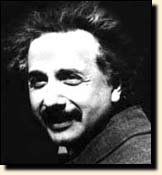
|
Einstein's new general theory of relativity predicted
a remarkable effect: when a ray of light passes near a
massive body, the ray should be bent. For example, starlight
passing near the sun should be slightly deflected by gravity.
This deflection could be measured when the sun's own light
was blocked during an eclipse. Einstein
predicted a specific amount of deflection, and the
prediction spurred British astronomers to try to observe
a total eclipse in May 1919. Feverish preparations began
as the war ended. Two expeditions, one to an island off
West Africa and the other to Brazil, succeeded in photographing
stars near the eclipsed sun. The starlight had been deflected
just as Einstein had predicted. |
